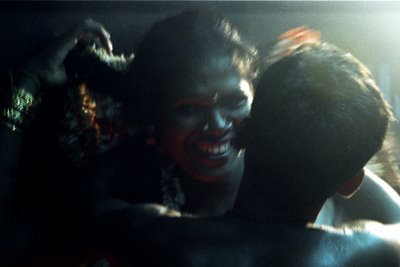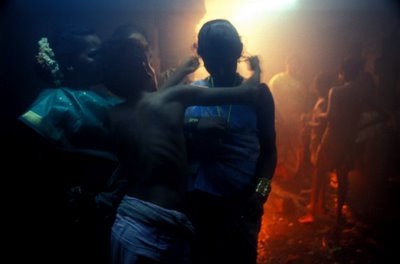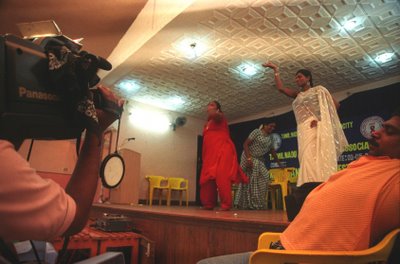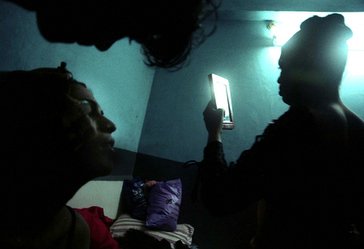
In India Homosexuality is illegal and under section 377 of the indian penal code punishable by a prison term of upto 10 years.
Long before the Indian penal code came into being, the tiny, non descript little village at Koovagam has hosted a festival thats been attended by tens of thousands of people of alternate sexuality for hundreds of years. It is considered the center of the "eunuch" world. Every year, this little village deep within Tamil Nadu assumes a festive look as over 25,000 eunuchs,transvestites, homosexual men and transsexuals descend on it from all over India and other countries as well for the 18-day long Aligal Thiruvizha festival. Shamayanas are erected, pujas planned, tea stalls set up and priests from the village prepare themselves for a profitable few days.
Shalini (not his real name) is a gay man married to a woman
What sets this festival apart from other festivals in the subcontinent is that most of the participants are people of "alternate" sexuality. Many, such as the hijras are considered neither male nor female, but belong to what is called the third gender, sometimes called eunuchs or Hijras, dressed in saris, with sprigs of jasmine in their hair and make up applied in mostly excessive fashion. In this write up I will refer to the attendees of this festival as hijras even though a larger spectrum of sexuality, if you will, attends. Hermaphrodites, castrated men, homosexual men, transsexuals and transvestites.
Inside the temple men get "married"
Most hijras seem keen to be referred to as women since they believe they are women trapped in men's bodies. Very few hijras are hermaphrodites — born with both male and female reproductive organs. A eunuch is a man or boy deprived of his external genitals, and although the term might apply to many hijras, it is often considered offensive. The local terms are interesting.
A "kothi" is a man who is sexually attracted to men and who adopts the female role in sexual partnerships; his partner is called a "panthi". Interestingly and given the homophobic nature of most Indian communities, predictably, also in attendance are "dangas", men who "become" women for the duration of the festival. The rest of the year, the dangas are husbands or single "heterosexual" men. These men get married to other men for the duration of the festival and then get divorced at its conclusion. The marriage involves a consumation and these men become acceptably "gay" for a few days.
The origins of this festival can be traced to a mythological story in which Aravan the son of Arjun and Nagakanni, was about to be sacrificed to goddess Kali, for the success of the Kurukshetra war. Arjun and Krishna were also in line to be sacrificed but because of their importance to the war effort and to save them, Aravan volunteered to be sacrificed but asked to be married before dying. As no one wanted to marry a man who was only going to live a day more, Krishna is said to have assumed the form of a beautiful woman Mohini and married Aravan.Hijras consider themselves a form of Krishna and "marry" this deity every year.
Each April, on the night of the full moon, this ancient myth comes to life in Koovagam, where Aravan is worshipped. Scores of make-shift stalls selling coconuts, flowers, and bangles spring up to cater to thousands of devotees from around the country who arrive on foot, plane, train, truck, bus, or bullock cart.
The tying of the mangalsutra
Bright, flashy, flamboyant costumes and make-up are the norm. The tying of mangalsutras, the sacred thread worn by married Hindu women, is a symbolic enactment of the Mohini-Aravanan marriage.

married!
The next day, an idol of the lord is taken around the town in procession and finally consigned to flames. A ritual mourning for the lost “husband” follows this marking the end of the festival and mangal sutras are deposited after much crying ands beating of breasts or should I say chests, on a large tree stump.
Abandoned mangalsutras after the "divorce"
One of the highlights of the festival is a beauty contest called the the 'Miss Koovagam' contest.
The competition is the first of its kind where hijras don’t have to hide who they are and flaunt what they have most unabashedly.
In India the life of a hijra is often marked by rejection, abuse, and loneliness. This festival is probably the only mass gathering of people of alternative sexuality and a place where they feel free to be who they are. At the end of the festival is the 'sacrifice'. Post the death of Aravanan the “husband”, people cut their 'thalis', break their bangles, don the white clothes of widows and wail in grief as would a new widow do upon the death of her husband.
And ends another year in the life of a hijra, a day in the sun, for the rest of the year is a very different story.
"For a few days we are free, and we marry a God" - Sarvathamma









0 comments:
Post a Comment